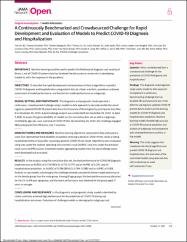A Continuously Benchmarked and Crowdsourced Challenge for Rapid Development and Evaluation of Models to Predict COVID-19 Diagnosis and Hospitalization

Göster/
Erişim
info:eu-repo/semantics/openAccessTarih
2021Yazar
Yan, YaoSchaffter, Thomas
Bergquist, Timothy
Yu, Thomas
Prosser, Justin
Aydin, Zafer
Jabeer, Amhar
Brugere, Ivan
Gao, Jifan
Chen, Guanhua
Causey, Jason
Yao, Yuxin
Bryson, Kevin
Long, Dustin R.
Jarvik, Jeffrey G.
Lee, Christoph, I
Wilcox, Adam
Guinney, Justin
Mooney, Sean
Üst veri
Tüm öğe kaydını gösterÖzet
IMPORTANCE Machine learning could be used to predict the likelihood of diagnosis and severity of illness. Lack of COVID-19 patient data has hindered the data science community in developing models to aid in the response to the pandemic.
OBJECTIVES To describe the rapid development and evaluation of clinical algorithms to predict COVID-19 diagnosis and hospitalization using patient data by citizen scientists, provide an unbiased assessment of model performance, and benchmark model performance on subgroups.
DESIGN, SETTING, AND PARTICIPANTS This diagnostic and prognostic study operated a continuous, crowdsourced challenge using a model-to-data approach to securely enable the use of regularly updated COVID-19 patient data from the University of Washington by participants from May 6 to December 23, 2020. A postchallenge analysis was conducted from December 24, 2020, to April 7, 2021, to assess the generalizability of models on the cumulative data set as well as subgroups stratified by age, sex, race, and time of COVID-19 test. By December 23, 2020, this challenge engaged 482 participants from 90 teams and 7 countries.
MAIN OUTCOMES AND MEASURES Machine learning algorithms used patient data and output a score that represented the probability of patients receiving a positive COVID-19 test result or being hospitalized within 21 days after receiving a positive COVID-19 test result. Algorithms were evaluated using area under the receiver operating characteristic curve (AUROC) and area under the precision recall curve (AUPRC) scores. Ensemble models aggregating models from the top challenge teams were developed and evaluated.
RESULTS In the analysis using the cumulative data set, the best performance for COVID-19 diagnosis prediction was an AUROC of 0.776 (95% CI, 0.775-0.777) and an AUPRC of 0.297, and for hospitalization prediction, an AUROC of 0.796 (95% CI, 0.794-0.798) and an AUPRC of 0.188. Analysis on top models submitting to the challenge showed consistently better model performance on the female group than the male group. Among all age groups, the best performance was obtained for the 25- to 49-year age group, and the worst performance was obtained for the group aged 17 years or younger.
CONCLUSIONS AND RELEVANCE In this diagnostic and prognostic study, models submitted by citizen scientists achieved high performance for the prediction of COVID-19 testing and hospitalization outcomes. Evaluation of challenge models on demographic subgroups and prospective data revealed performance discrepancies, providing insights into the potential bias and limitations in the models.
Kaynak
JAMA NETWORK OPENCilt
Volume 4 Issue 10Bağlantı
https //doi.org/10.1001/jamanetworkopen.2021.24946https://hdl.handle.net/20.500.12573/1243

















